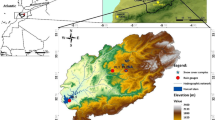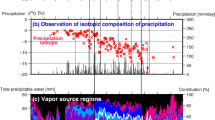Abstract
Long term (2005–2016) daily precipitation isotope data (δ18O, δD and d-excess) from Ahmedabad in semi-arid Western India are examined in light of various meteorological parameters and air parcel trajectories to identify prominent patterns in the isotopic character and discern the underlying hydrometeorological processes. One of the most prominent and systematic annual patterns is the isotopic depletion (average δ18O: − 2.5‰ in Jun–Jul; − 5.2‰ in Aug–Sept) in the second half of the Indian Summer Monsoon (ISM), which is observed in the 11 out of the 12 years of this study. Four geographically feasible causal factors have been examined if they contribute to observed late monsoon isotopic depletion. These factors are: (1) increased contribution of terrestrially recycled vapor; (2) intra-seasonal change in sea-surface, surface-air and cloud base temperatures; (3) increased rain-out fraction from marine vapor parcel; and (4) increase in relative proportion of convective rain. It is inferred from the present study that isotopic depletion in the second half of ISM is associated with: (1) increased contribution (45% from 36%) of terrestrially recycled moisture; (2) 1.9° C lower cloud base temperature; (3) increased rainout fraction due to decreased wind velocity (6.9 m/s from 8.8 m/s); and (4) an increase of 22.3% in the proportion of convective rain. Daily rain events with atypical isotopic composition (20‰ < d-excess < 0‰) are ascribed mainly to local weather perturbations causing sudden updraft of moist air facilitating terrestrial recycling of water vapor.







Similar content being viewed by others
References
Aggarwal PK et al (2012) Stable isotopes in global precipitation: a unified interpretation based on atmospheric moisture residence time. Geophys Res Lett 39(11):L11705
Aggarwal PK et al (2016) Proportions of convective and stratiform precipitation revealed in water isotope ratios. Nat Geosci 9(8):624–629
Bates BC, Kundzewicz ZW, Wu S, Palutikof JP (2008) Climate change and water. Technical paper of the intergovernmental panel on climate change. IPCC Secretariat, Geneva
Breitenbach SF et al (2010) Strong influence of water vapor source dynamics on stable isotopes in precipitation observed in Southern Meghalaya, NE India. Earth Planet Sci Lett 292(1–2):212–220
Camargo JR, Ebinuma CD, Silveira JL (2005) Experimental performance of a direct evaporative cooler operating during summer in a Brazilian city. Int J Refrig 28:1124–1132
Clark ID, Fritz P (1997) Environmental isotopes in hydrogeology. Lewis, Boca Raton, p 328
Dansgaard W (1964) Stable isotopes in precipitation. Tellus 16:436–438
Das PK (2005) The monsoons. National book trust, New Delhi, p 252
De US, Dube RK, Rao GSP (2005) Extreme weather events over india in the last 100 years. J Indian Geophys Union 9(3):173–187
Deshpande RD (2006) Groundwater in and around Cambay Basin, Gujarat: Some geochemical and isotopic investigations. Ph.D. Thesis, M.S. University of Baroda, Vadodara, India, pp 158.
Deshpande RD, Gupta SK (2008) National Programme on Isotope fingerprinting of waters of India (IWIN). Glimpses of Geosciences Research in India, the Indian Report to IUGS, Indian National Science Academy, Singhvi AK, Bhattacharya A, Guha S (eds), INSA, New Delhi, 10–16
Deshpande RD, Gupta SK (2012) Oxygen and hydrogen isotopes in hydrological cycle: new data from IWIN National Programme. Proc Indian Natl Sci Acad 78(3):321–331
Deshpande RD, Maurya AS, Kumar B, Sarkar A, Gupta SK (2010) Rain-vapor interaction and vapor source identification using stable isotopes from Semi-Arid Western India. J Geophys Res 115:D23311
Deshpande RD et al (2013) Isotopic studies of megacryometeors in western India. Curr Sci 104(6):728–737
Deshpande RD, Dave M, Padhya V, Kumar H, Gupta SK (2015) Water vapour source identification for daily rain events at Ahmedabad in semi-arid western India: wind trajectory analyses. Meteorol Appl 22(4):754–762
Dwivedi S, Narayanan MS, Venkat Ratnam M, Narayana Rao D (2016) Characteristics of monsoon inversions over the Arabian Sea observed by satellite sounder and reanalysis data sets. Atmos Chem Phys 16(7):4497–4509
Gat JR (1996) Oxygen and hydrogen isotopes in the hydrological cycle. Ann Rev Earth Planet Sci 24:225–262
Gonfiantini R (1986) Environmental isotopes in lake studies. In: Fritz P, Fontes J-C (eds) Handbook of environmental isotope geochemistry. Elsevier, Amsterdam, pp 113–168
Goswami BN, Venugopal V, Sengupta D, Madhusoodanan MS, Xavier PK (2006) increasing trend of extreme rain events over india in a warming environment. Science 314(5804):1442–1445
Guhathakurta P, Sreejith OP, Menon PA (2011) Impact of climate change on extreme rainfall events and flood risk in India. J Earth Syst Sci 120(3):359–373
Gupta SK, Deshpande RD (2003) Synoptic hydrology of India from the data of isotopes in precipitation. Curr Sci 85(11):1591–1595
Hartmann DL et al. (2013) Observations: atmosphere and surface. In: Stocker TF et al. (Eds) The physical science basis. Contribution of Working Group I to the Fifth Assessment Report of the Intergovernmental Panel on Climate Change. Cambridge University Press, Cambridge, United Kingdom and New York, NY, USA
Horita J, Wesolowski DJ (1994) Liquid-vapor fractionation of oxygen and hydrogen isotopes of water from the freezing to the critical temperature. Geochim Cosmochim Acta 58(16):3425–3437
Huang B et al (2017) Extended reconstructed sea surface temperature, version 5 (ERSSTv5): upgrades, validations, and intercomparisons. J Clim 30(20):8179–8205
Jeelani G, Deshpande RD, Shah RA, Hassan W (2017) Influence of southwest monsoons in the Kashmir Valley, western Himalayas. Isot Environ Health Stud 53(4):400–412
Jeelani G, Deshpande RD, Galkowski M, Rozanski K (2018) Isotopic composition of daily precipitation along the southern foothills of the Himalayas: impact of marine and continental sources of atmospheric moisture. Atmos Chem Phys 18:8789–8805
Kalnay E et al (1996) The NCEP/NCAR 40-year reanalysis project. Bull Am Meteorol Soc 77(3):437–472
Kashid SS, Maity R (2012) Prediction of monthly rainfall on homogeneous monsoon regions of India based on large scale circulation patterns using Genetic Programming. J Hydrol 454–455:26–41
Krishna Kumar K, Rajagopalan B, Hoerling M, Bates G, Cane M (2006) Unraveling the mystery of indian monsoon failure during El Nino. Science 314:115–119
Krishnamurthy CKB, Lall U, Kwon H-H (2009) Changing frequency and intensity of rainfall extremes over India from 1951 to 2003. J Clim 22(18):4737–4746
Lee J-E et al (2012) Asian monsoon hydrometeorology from TES and SCIAMACHY water vapor isotope measurements and LMDZ simulations: Implications for speleothem climate record interpretation. J Geophys Res. https://doi.org/10.1029/2011jd017133
Lekshmy PR, Midhun M, Ramesh R, Jani RA (2014) 18O depletion in monsoon rain relates to large scale organized convection rather than the amount of rainfall. Sci Rep 4:5661
Lekshmy P, Midhun M, Ramesh R (2015a) Spatial variation of amount effect over peninsular India and Sri Lanka: role of seasonality. Geophys Res Lett 42(13):5500–5507
Lekshmy PR, Midhun M, Ramesh R (2015b) Spatial variation of amount effect over peninsular India and Sri Lanka: role of seasonality. Geophys Res Lett 42:5500–5507
Mahakur M et al (2013) A high-resolution outgoing longwave radiation dataset from kalpana-1 satellite during 2004-2012. Curr Sci 105(8):1124–1133
Masson-Delmotte V et al. (2013) Information from paleoclimate archives. In: Stocker TF et al. (Eds) Climate change 2013: The physical science basis. Contribution of Working Group I to the Fifth Assessment Report of the Intergovernmental Panel on Climate Change Cambridge University Press, Cambridge, United Kingdom and New York, NY, USA
Maurya AS, Shah M, Deshpande RD, Gupta SK (2009) Protocol for δ18O and δD analyses of water sample using Delta V plus IRMS in CF Mode with Gas Bench II for IWIN National Programme at PRL, Ahmedabad. In: Aggarwal SK, Jaison PG, Sarkar A, Kumar P (Eds), 11th ISMAS Triennial Conference of Indian Society for Mass Spectrometry. Indian Society for Mass Spectrometry, Hyderabad pp: 314-317
Midhun M et al (2018) The effect of monsoon circulation on the stable isotopic composition of rainfall. J Geophys Res 123(10):5205–5221
Narayanan MS, Rao BM, Shah S, Prasad VS, Bhat GS (2004) Role of atmospheric stability over the Arabian Sea and the unprecedented failure of monsoon 2002. Curr Sci 86(7):938–947
Niranjan Kumar K, Rajeevan M, Pai DS, Srivastava AK, Preethi B (2013) On the observed variability of monsoon droughts over India. Weather Clim Extrem 1:42–50
Rahul P, Ghosh P (2018) Long term observations on stable isotope ratios in rainwater samples from twin stations over Southern India; identifying the role of amount effect, moisture source and rainout during the dual monsoons. Clim Dyn. https://doi.org/10.1007/s00382-018-4552-1
Rao TN, Saikranthi K, Radhakrishna B, Rao SVB (2016) Differences in the climatological characteristics of precipitation between active and break spells of the Indian summer monsoon. J Clim 29:7797–7814
Rozanski K, Araguas-Araguas L, Gonfiantini R (1993) Isotopic Patterns in Modern Global Precipitation. In: Swart PK (ed) Climate change in continental isotopic records. Geophysical monograph series. American Geophysical Union, Washington, pp 1–36
Saikranthi K, Rao TN, Radhakrishna B, Rao SVB (2014) Morphology of the vertical structure of precipitation over India and adjoining oceans based on long-term measurements of TRMM PR. J Geophy Res. https://doi.org/10.1002/2014JD021774
Saranya P, Krishan G, Rao MS, Kumar S, Kumar B (2018) Controls on water vapor isotopes over Roorkee, India: impact of convective activities and depression systems. J Hydrol 557:679–687
Sengupta S, Sarkar A (2006) Stable isotope evidence of dual (Arabian Sea and Bay of Bengal) vapour sources in monsoonal precipitation over north India. Earth Planet Sci Lett 250(3–4):511–521
Singh P, Khan TMA, Rahman MS (2001) Has the frequency of intense tropical cyclones increased in the north Indian Ocean? Curr Sci 80(4):575–580
Sodemann H, Masson-Delmotte V, Schwierz C, Vinther BM, Wernli H (2008a) Interannual variability of Greenland winter precipitation sources: 2. Effects of North Atlantic Oscillation variability on stable isotopes in precipitation. J Geophys Res 113(D12):D12111
Sodemann H, Schwierz C, Wernli H (2008b) Interannual variability of Greenland winter precipitation sources: lagrangian moisture diagnostic and North Atlantic Oscillation influence. J Geophys Res 113(D3):D03107
Stein A et al (2015) NOAA’s HYSPLIT atmospheric transport and dispersion modeling system. Bull Am Meteorol Soc 96(12):2059–2077
Stocker TF. et al. (2013) IPCC, 2013: Summary for Policymakers. In: Climate change 2013: The physical science basis. Contribution of Working Group I to the Fifth Assessment Report of the Intergovernmental Panel on Climate Change. Cambridge University Press, Cambridge, United Kingdom and New York, NY, USA
Trenberth KE, Shea DJ (2005) Relationships between precipitation and surface temperature. Geophys Res Lett 32:L14703
Warrier CU, Babu MP (2011) A comparative study on isotopic composition of precipitation in wet tropic and semi-arid stations across southern India. J Earth Syst Sci 120(6):1085–1094
Acknowledgements
The work reported here is carried out under the aegis of a National Programme on Isotope Fingerprinting of Waters of India (IWIN), which was initially funded jointly by the Department of Science and Technology (DST), Government of India, vide Grant No. IR/S4/ESF-05/2004, and the Physical Research Laboratory (PRL), a Unit under the Department of Space, Government of India. The IWIN National Programme is currently sustained by the PRL. Authors sincerely thank the three anonymous reviewers for their careful review, critical comments and constructive suggestions, which significantly improved the quality of this study. Authors thank the Executive Editor Dr. Jianping Li for the kind patience during the process of review and revision.
Author information
Authors and Affiliations
Corresponding author
Additional information
Publisher's Note
Springer Nature remains neutral with regard to jurisdictional claims in published maps and institutional affiliations.
Electronic supplementary material
Below is the link to the electronic supplementary material.
Rights and permissions
About this article
Cite this article
Oza, H., Padhya, V., Ganguly, A. et al. Hydrometeorological processes in semi-arid western India: insights from long term isotope record of daily precipitation. Clim Dyn 54, 2745–2757 (2020). https://doi.org/10.1007/s00382-020-05136-2
Received:
Accepted:
Published:
Issue Date:
DOI: https://doi.org/10.1007/s00382-020-05136-2




